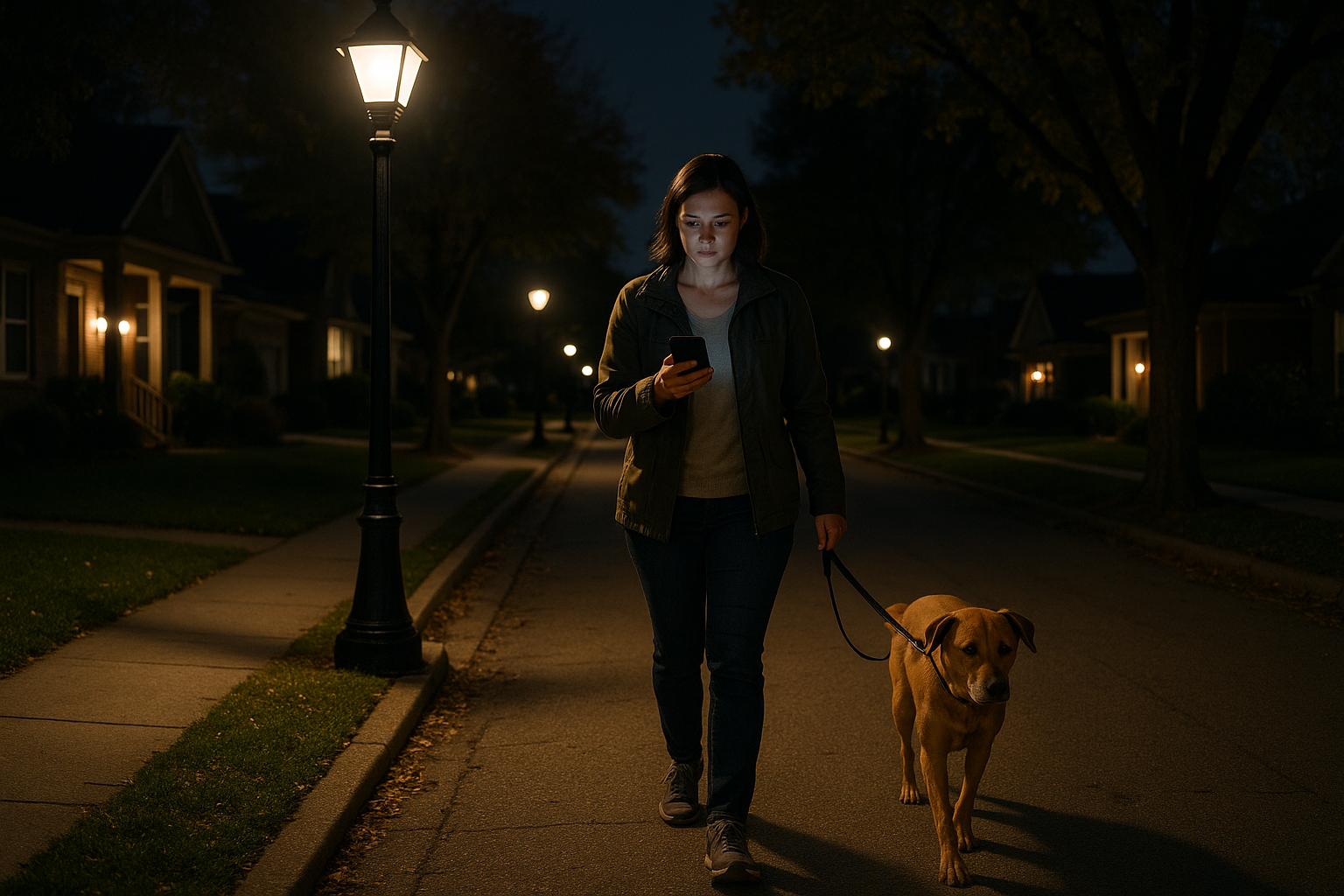However, navigating this darkness is not without its risks. 🌃 From accidents to crime, nighttime presents a unique set of challenges that demand a unique set of solutions. This is where our topic today, “Stay Safe After Dark: Tips for Nighttime Safety and Security,” comes into play.
Nighttime safety and security is a broad topic, covering everything from personal safety while walking on dimly lit streets to securing homes and businesses against potential threats. In this blog post, we will explore a host of strategies, technologies, and best practices that can help keep you safe after dark. 🦉 Whether you are a night owl, an early riser, or someone who occasionally ventures out into the night, the information in this post is sure to be valuable.
Why Nighttime Safety Matters
Before we dive into the specifics, let’s take a moment to understand why nighttime safety matters. Accidents and crime rates tend to spike after sunset. This can be attributed to a variety of factors such as reduced visibility, increased fatigue, and the perceived anonymity that darkness provides. By being aware of these risks and learning how to mitigate them, we can drastically reduce the likelihood of falling victim to such incidents. 🌚
What to Expect in This Blog Post
Given the breadth and depth of the subject matter, this post will be divided into several key sections, each focusing on different aspects of nighttime safety and security. 💡 We will kick things off with a detailed discussion on personal safety tips for navigating the outdoors after dark. This will cover topics like safe walking practices, what to wear, and how to respond to potential threats.
Next, we will pivot to discuss home security, focusing on how you can make your home a harder target for would-be burglars or vandals. From lighting to security systems, we’ll provide actionable tips that can help you fortify your home and sleep easier at night.
Then, we will shift gears to talk about cybersecurity. In the digital age, our nights can be as fraught with dangers as our days, with cybercriminals often exploiting the cover of night to launch their attacks. We’ll discuss ways you can protect yourself and your digital assets when the sun goes down.
The Importance of Vigilance and Preparedness
Throughout this discussion, two themes will recur: vigilance and preparedness. Nighttime safety and security isn’t about living in fear of the dark; it’s about being aware of the risks and knowing how to counter them effectively. By being vigilant and prepared, you can navigate the night confidently and securely, whether you’re strolling down a moonlit street, securing your home, or surfing the web. 🌟
So, let’s pull back the shadows and illuminate the darkness. Read on for a comprehensive guide to staying safe after dark. 🌙
Understanding the Importance of Nighttime Safety and Security
As the sun sets and darkness falls, safety and security become increasingly important. Unfortunately, many individuals overlook or underestimate the necessity of implementing proper precautions after dark. This might be due to a lack of awareness or because they believe it’s unnecessary. Regardless, the fact remains: ensuring personal and property security at night is a crucial part of overall safety.
It’s a common misconception that ‘it won’t happen to me,’ but crime statistics show that burglaries and assaults often occur during nighttime hours. As Rodrigo Almeida, I have extensive experience in engineering and software, particularly security software, and I have noticed a significant increase in the demand for nighttime security systems. Therefore, it’s more important than ever to stay informed and adopt safety measures that will keep you, your family, and your property safe.
So, let’s delve into practical tips, innovative technologies, and effective strategies to ensure your safety and security after dark. Take a look at the table below to have a snapshot of the steps we will discuss in the upcoming sections.
| Category | Tips |
|---|---|
| Personal Safety | Visibility, Awareness, Communication |
| Home Security | Lighting, Surveillance Systems, Locks |
| Vehicle Safety | Safe Parking, Vehicle Alarm Systems, Locks |
Enhancing Personal Safety: Be Visible, Aware, and Connected
Personal safety at night involves strategies that make you less of a target to potential threats. Key concepts to remember are visibility, awareness, and communication.
Visibility: This refers to how well you can see and be seen at night. It’s crucial to stay in well-lit areas and wear reflective clothing when walking or running at night. A useful tool to enhance visibility is a flashlight. Not only does it help you see your surroundings, but it also makes you more noticeable.
Awareness: Being mindful of your surroundings is key. Always be aware of who is around you and what’s going on. Avoid distractions like headphones or smartphones that might hinder your ability to notice potential dangers.
Communication: Always let someone know where you’re going, who you’re with, and when you’re expected to return. In case of emergencies, this information can be vital. It’s also a good idea to have emergency numbers readily available.
A great video that explains these points in detail is “Nighttime Safety Tips” by the Safe Communities Coalition on YouTube. It provides valuable insights and practical examples.
Securing Your Home: Lighting, Surveillance, and Locks
Your home is your sanctuary, and its security should not be compromised. Implementing effective security measures can deter potential burglars and provide peace of mind. The table below provides a comparative analysis of various home security measures.
| Security Measure | Pros | Cons |
|---|---|---|
| Outdoor Lighting | Deters intruders, increases visibility | Can increase energy consumption |
| Surveillance Systems | Can provide evidence, often include alarms | Can be expensive, require regular maintenance |
| High-Quality Locks | Effective deterrent, relatively inexpensive | Can be broken, regular keys can be lost |
You might also want to consider “smart” options, such as smart locks and security systems that you can control and monitor from your smartphone. These systems can provide real-time alerts and give you an extra level of control and reassurance.
If you want to know more about home security systems, you should watch the “Home Security Systems: A Beginner’s Guide” video by the Home Repair Tutor channel on YouTube.
Vehicle Safety After Dark: Safe Parking, Alarm Systems, and Locks
Your vehicle, like your home, is an investment that deserves protection. Here are a few key points to consider:
Safe Parking: Always aim to park in well-lit, populated areas. Avoid parking in isolated, dark places that may be attractive to potential thieves.
Alarm Systems and Locks: Vehicle alarm systems and sturdy locks are effective deterrents to car thieves. Modern vehicles often come equipped with sophisticated alarm systems. If your vehicle lacks such features, consider investing in aftermarket options.
Valuables: Never leave valuables visible in your car. If a thief sees something they want in your vehicle, they are far more likely to attempt a break-in. Always take your valuables with you or hide them in the trunk.
For a visual guide on vehicle safety, check out the video “Car Safety Tips for Nighttime Driving” by AutoMotoTube on YouTube. It offers practical advice on how to secure your vehicle after dark.
Staying Safe Online After Dark
In today’s digital age, we also need to consider our online safety after dark. Cybercriminals are becoming increasingly sophisticated, often using the cover of night to launch their attacks. To protect yourself, ensure your devices are secure, be cautious when using public Wi-Fi, use strong passwords, and always install updates promptly. A great video resource to understand online safety in depth is “Internet Safety: Tips for Protecting Yourself Online” by the Norton channel on YouTube.
Remember, your safety and security are paramount, and it’s crucial to take proactive steps to protect yourself, your family, and your belongings. Stay safe, stay vigilant!

Conclusion
In conclusion, it’s hard to ignore the significance of the topics we have extensively covered in this article. The digital era is here, and it brings along complex concepts and methodologies that require expertise and deep understanding. As your guide through the labyrinth of Information Technology and Engineering concepts, it’s my responsibility to simplify these concepts for you.
We began this expedition into the world of technology by delving into the core principles of software engineering. We then unearthed the intricacies of systems integration and the importance of APIs in modern tech stacks. The journey further took us into the realm of cybersecurity, where we unfolded the significance of robust security measures and mitigations against potential threats.
Next, we explored the world of cloud computing, touching on pivotal concepts such as IaaS, PaaS, and SaaS. We learned how these services are revolutionizing the way businesses operate, by providing scalable, flexible, and cost-effective solutions. At this point, our journey was far from over. We ventured into the field of data analytics, where we learned how businesses are harnessing data to make informed decisions and gain competitive advantage.
Let’s not forget the vital role that Agile methodologies play in today’s project management landscape. The principles of Agile provide a framework for efficient and effective project management, ensuring that businesses can quickly adapt to changes and deliver high-quality products to their customers.
Now, as we reach the end of this journey, I encourage you to reflect on what we have learned. Each of these topics holds immense value in the world of tech, and by understanding them, you are better equipped to navigate the constantly evolving digital landscape.
I invite you to further explore these topics, to dig deeper into each area, and uncover new insights. Feel free to use the provided links to access a wealth of knowledge from reliable sources. Each link is an active resource that will enrich your understanding and help you stay updated with the latest trends and developments.
As always, I appreciate your feedback and comments. Engaging with you helps me better understand your needs and tailor my content accordingly. So, don’t hesitate to leave a comment below or share this article with your network. Your participation is key to a more enriching learning experience for everyone.
I believe in the power of sharing knowledge. If there’s anything in this article you found useful, or if you implemented any of the concepts discussed, let me know! It’s inspiring to see how these technical insights can bring real-world benefits to you and your organization.
Finally, I leave you with a quote that resonates with the spirit of this article, “The science of today is the technology of tomorrow” – Edward Teller. So, let’s keep exploring, keep learning, and keep growing in this fascinating world of technology.
The future is in our hands!🌐💻🚀
Links:
- Systems Integration: What You Need to Know
- What is Cyber Security? Definition, Best Practices & More
- What is Cloud Computing?
- What is Data Analytics?
- What is Agile?



